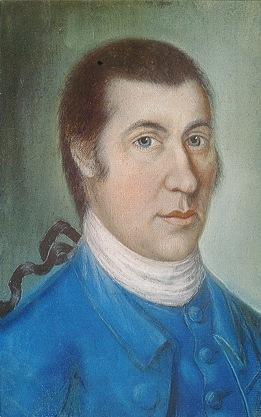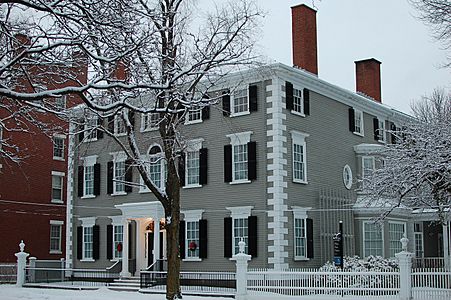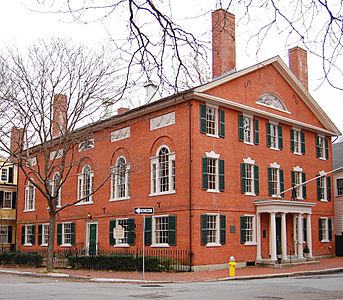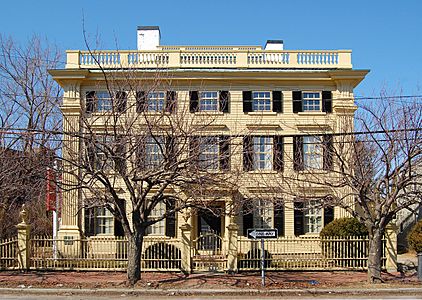Samuel McIntire facts for kids
Samuel McIntire (born January 16, 1757 – died February 6, 1811) was a famous American architect and craftsman. An architect designs buildings, and a craftsman is skilled at making things by hand. He is most known for his work in the Chestnut Street District. This area shows off the beautiful Federal style architecture, which was popular in the U.S. after the American Revolution.
Contents
Samuel McIntire's Life and Work
Samuel McIntire was born in Salem, Massachusetts. His father, Joseph McIntire, was a house builder. Samuel started his career as a woodcarver. Over time, he became very skilled in architecture.
He married Elizabeth Field on October 10, 1778. They had one son. In 1786, Samuel built a simple home and workshop for his family.
Designing Homes for Wealthy Merchants
Around 1780, a very rich merchant named Elias Hasket Derby hired McIntire. Derby was one of America's first millionaires. McIntire designed or updated many homes for Derby's family.
McIntire taught himself the Palladian style of architecture. He learned from books. Soon, he became known for designing elegant homes for the city's wealthy people. In 1792, he even submitted a design for the United States Capitol building.
McIntire's Architectural Style
After 1797, McIntire started working in a style similar to Boston architect Charles Bulfinch. Bulfinch made the neoclassical style popular in America. This style was inspired by Scottish architect Robert Adam.
Unlike Bulfinch, whose designs were seen across the East Coast, McIntire mostly built in New England. His houses were usually made of wood or brick. They were often three stories tall. Each house had four rooms around a central hallway.
In 1799, he started a business with his brothers, Joseph and Angier McIntire. His brothers built the structures. Samuel oversaw the decorations in his workshop. These decorations often included carvings of swags, rosettes, garlands, and sheaves of wheat. These designs were common on the wooden surfaces inside the homes.
Famous Buildings by McIntire
Some of McIntire's famous works in Salem include the Peirce-Nichols House, Peabody-Silsbee House, and Gardner-White-Pingree House. He also designed public buildings in Salem. These include Assembly Hall, Hamilton Hall, and Washington Hall. The courthouse was also his design, but Washington Hall and the courthouse no longer exist.
McIntire's Craftsmanship and Art
McIntire was a very skilled artisan, especially with furniture. He was also talented at sculpting. He created busts (sculptures of a person's head and shoulders) of famous figures. These included Voltaire and John Winthrop, who was the first governor of Massachusetts. These busts are now kept at the American Antiquarian Society in Worcester, Massachusetts.
One of his famous furniture pieces is the McIntire Chair. This chair was part of a large set made for Elias Hasket Derby. Its design was based on a guide from London, but McIntire added his own detailed carvings. He often used carved grape clusters and bowknots in his designs.
Samuel McIntire was buried in the Burying Point Cemetery in Salem. His gravestone describes him as a genius in architecture, sculpture, and music. It also says he was modest, kind, hardworking, and honest.
Samuel McIntire Historic District
The Samuel McIntire Historic District was created in 1981. It combines two older historic districts. This large district includes about 249 buildings. It covers parts of Essex, Broad, and Warren Streets, and other nearby areas. The district is named after Samuel McIntire because he lived and worked there. His home was at 31 Summer Street.
Important Buildings in the District
Many of McIntire's important works are in this district. The Peirce-Nichols House (built in 1782) was his first big project. Hamilton Hall (built in 1805) is another one of his later works.
Chestnut Street is a key part of the district. It has many Federal Era townhouses designed by McIntire. This street shows how important Salem was for trade and shipping in the late 1700s and early 1800s.
The Samuel McIntire Historic District has one of the largest collections of old homes in America. Most of the major architectural styles from 1640 to 1940 are represented here. The district also includes the Witch House (built around 1642), churches, and the Broad Street Burial Ground (from 1655).
World Record for Federal Furniture
In 2011, a mahogany side chair carved by Samuel McIntire was sold. It went for $662,500 at an auction. This set a new world record for Federal furniture. The chair was handmade in the late 1790s. It was one of eight chairs originally bought by Elizabeth and Elias Hasket Derby.
Gallery
-
Peirce-Nichols House (1782) at 80 Federal Street in Salem, Massachusetts. You can take tours here.
See also
 In Spanish: Samuel McIntire para niños
In Spanish: Samuel McIntire para niños






